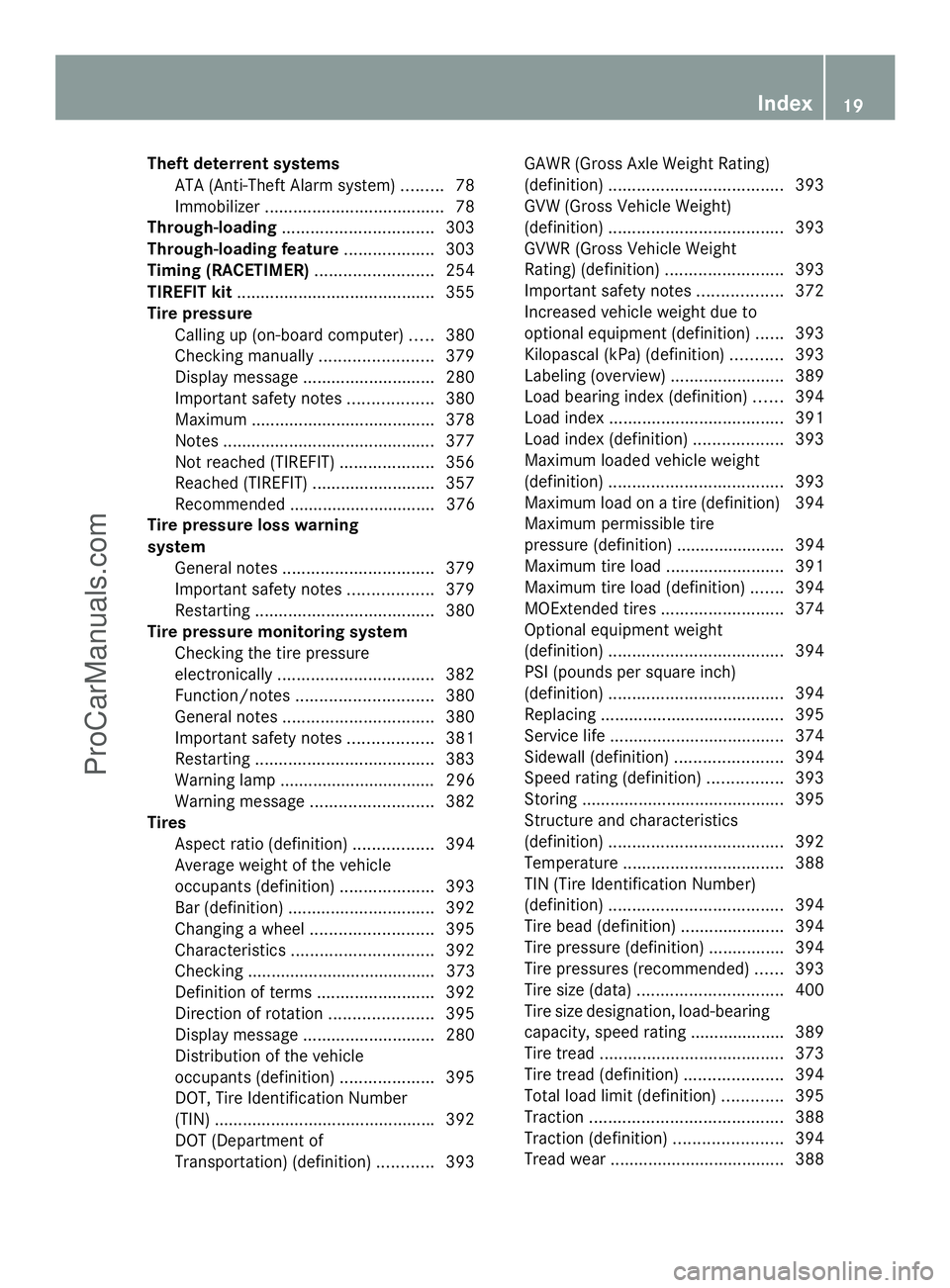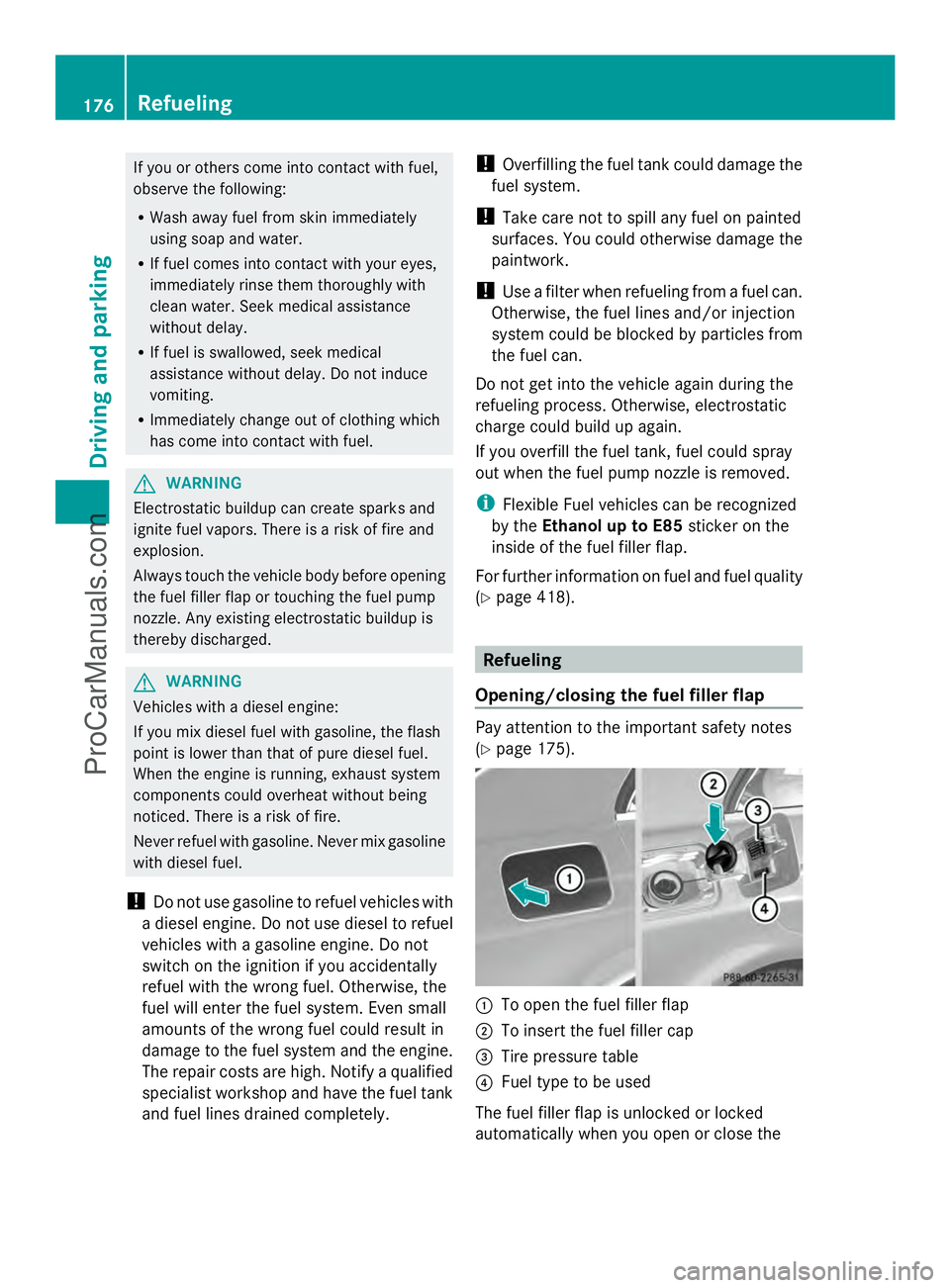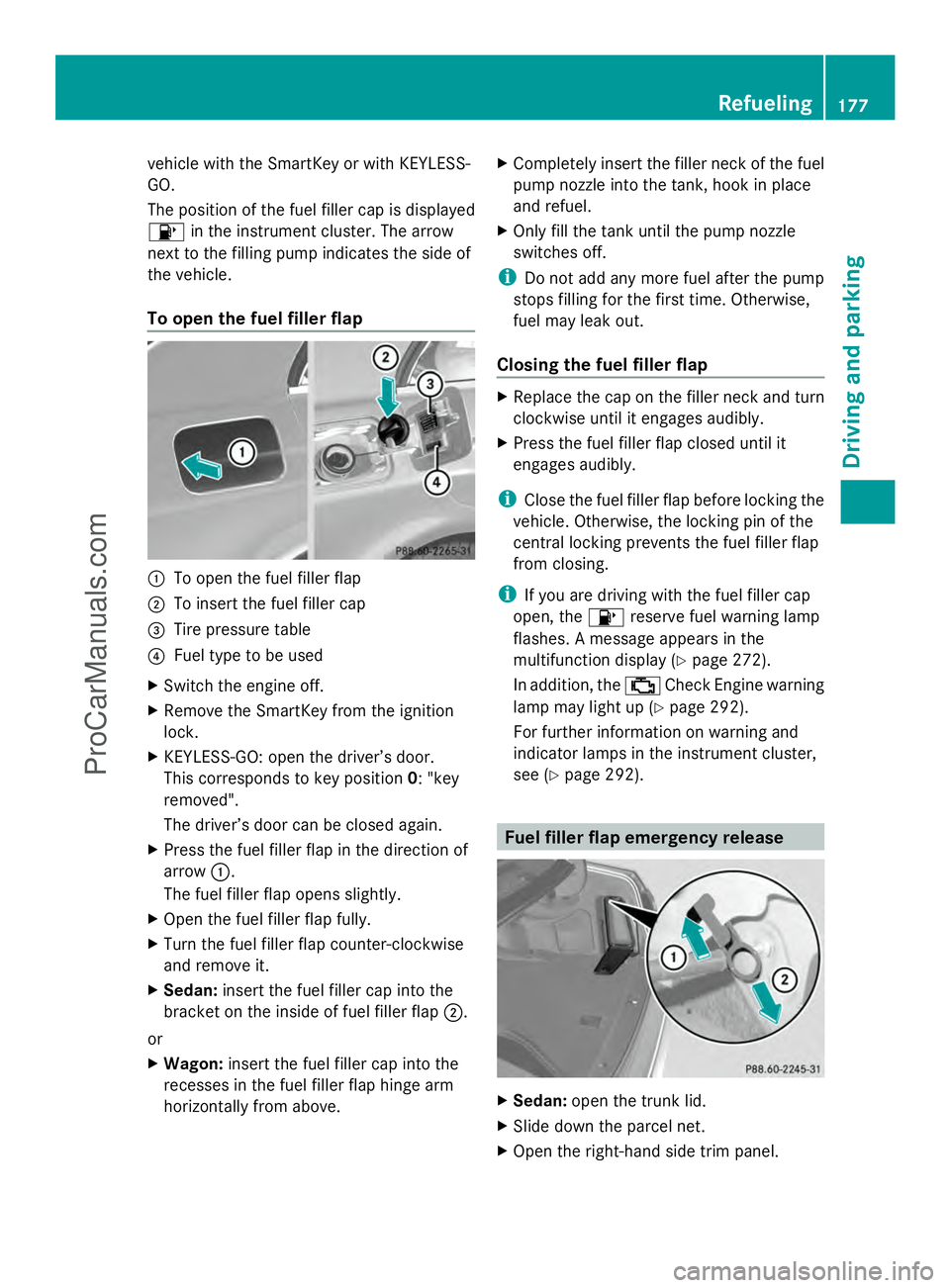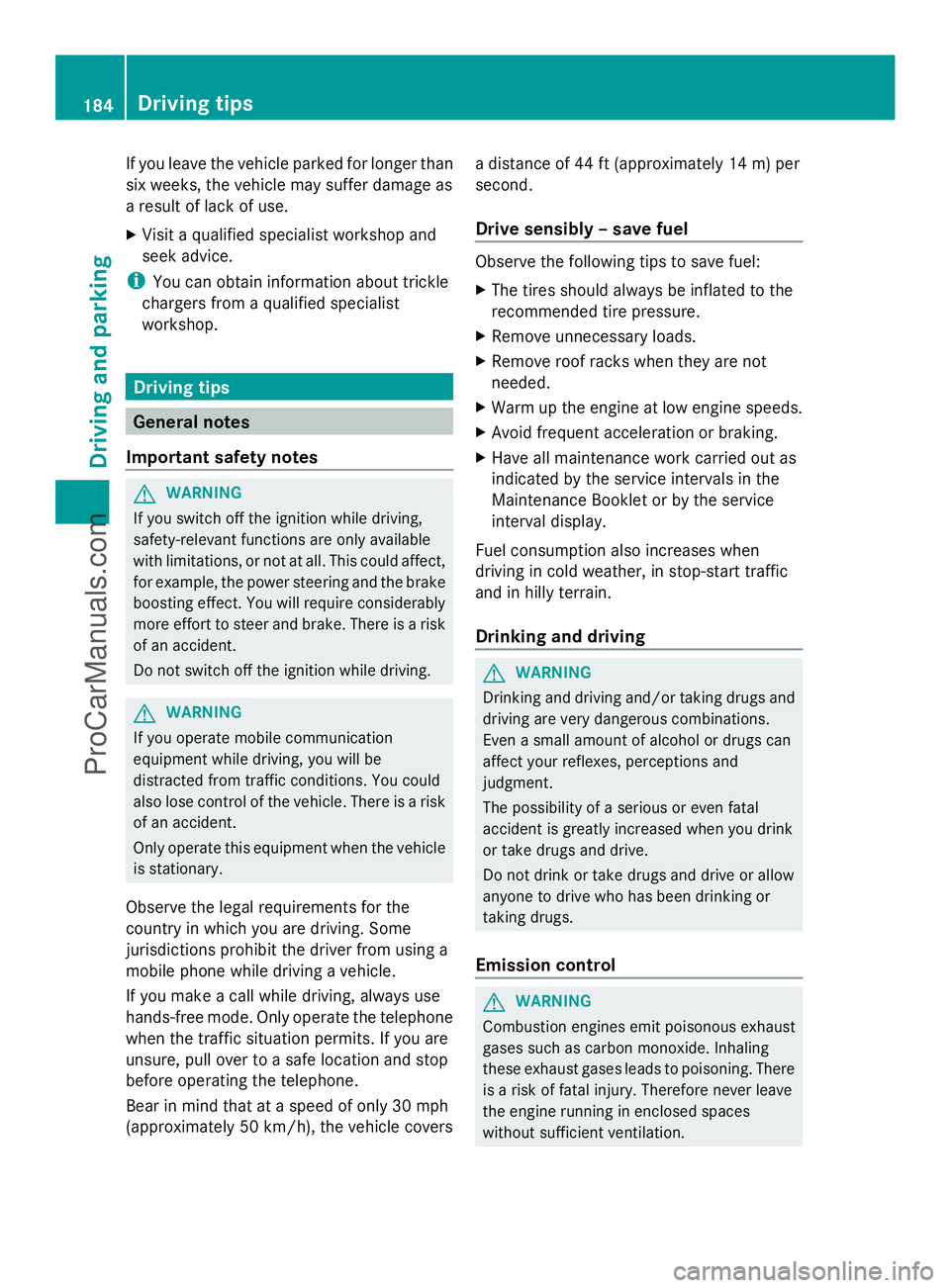2014 MERCEDES-BENZ E-SEDAN tire pressure
[x] Cancel search: tire pressurePage 21 of 430

Theft deterrent systems
ATA (Anti-Theft Alarm system )......... 78
Immobilizer ...................................... 78
Through-loading ................................ 303
Through-loading feature ...................303
Timing (RACETIMER) .........................254
TIREFIT kit .......................................... 355
Tire pressure Calling up (on-board computer) .....380
Checking manually ........................379
Display message ............................ 280
Important safety notes ..................380
Maximum ....................................... 378
Notes ............................................. 377
Not reached (TIREFIT) ....................356
Reached (TIREFIT) ..........................357
Recommended ............................... 376
Tire pressure loss warning
system
General notes ................................ 379
Important safety notes ..................379
Restarting ...................................... 380
Tire pressure monitoring system
Checking the tire pressure
electronically ................................. 382
Function/notes ............................. 380
General notes ................................ 380
Important safety notes ..................381
Restarting ...................................... 383
Warning lamp ................................. 296
Warning message .......................... 382
Tires
Aspect ratio (definition) .................394
Average weight of the vehicle
occupants (definition) ....................393
Bar (definition) ............................... 392
Changing a wheel .......................... 395
Characteristics .............................. 392
Checking ........................................ 373
Definition of terms .........................392
Direction of rotatio n...................... 395
Display message ............................ 280
Distribution of the vehicle
occupants (definition) ....................395
DOT, Tire Identification Number
(TIN) .............................................. .392
DOT (Department of
Transportation) (definition) ............393 GAWR (Gross Axle Weight Rating)
(definition)
..................................... 393
GVW (Gross Vehicle Weight)
(definition) ..................................... 393
GVWR (Gross Vehicle Weight
Rating) (definition) .........................393
Important safety notes ..................372
Increased vehicle weight due to
optional equipment (definition) ......393
Kilopascal (kPa) (definition) ...........393
Labeling (overview )........................ 389
Load bearing index (definition) ......394
Load index ..................................... 391
Load index (definition) ...................393
Maximum loaded vehicle weight
(definition) ..................................... 393
Maximum load on a tire (definition) 394
Maximum permissible tire
pressure (definition) ....................... 394
Maximum tire loa d......................... 391
Maximum tire load (definition) .......394
MOExtended tires ..........................374
Optional equipment weight
(definition) ..................................... 394
PSI (pounds per square inch)
(definition) ..................................... 394
Replacing ....................................... 395
Service life ..................................... 374
Sidewall (definition) .......................394
Speed rating (definition) ................393
Storing ........................................... 395
Structure and characteristics
(definition) ..................................... 392
Temperature .................................. 388
TIN (Tire Identification Number)
(definition) ..................................... 394
Tire bead (definition) ......................394
Tire pressure (definition) ................394
Tire pressures (recommended )...... 393
Tire size (data) ............................... 400
Tire size designation, load-bearing
capacity, speed rating .................... 389
Tire tread ....................................... 373
Tire tread (definition) .....................394
Total load limit (definition) .............395
Traction ......................................... 388
Traction (definition) .......................394
Tread wea r..................................... 388 Index
19ProCarManuals.com
Page 23 of 430

W
Warning and indicator lamps ABS ................................................ 288
Brakes ........................................... 287
Check Engine ................................. 292
Coolant .......................................... 293
Distance warning ........................... 295
DISTRONIC PLUS ........................... 295
ESP ®
.............................................. 289
ESP ®
OFF ....................................... 290
Fuel tank ........................................ 292
Overview .......................................... 32
PASSENGER AIRBAG OFF ................48
Reserve fuel ................................... 292
Seat belt ........................................ 285
SPORT handling mode ...................290
SRS ................................................ 291
Tire pressure monitor ....................296
Warranty ............................................ 416
Washer fluid Display message ............................ 283
Wheel bolt tightening torque ...........400
Wheel chock ...................................... 396
Wheels Changing a wheel .......................... 395
Checking ........................................ 373
Cleaning ......................................... 344
Cleaning (warning) .........................395
Emergency spare wheel .................410
Important safety notes ..................372
Interchanging/changing ................395
Mounting a new wheel ...................399
Mounting a wheel .......................... 396
Removing a wheel ..........................399
Storing ........................................... 395
Tightening torque ........................... 400
Wheel size/tire size .......................400
Window curtain air bag
Operation ........................................ .47
Windows
see Side windows
Windshield
Defrosting ...................................... 152
Windshield washer fluid
see Windshield washer system Windshield washer system
Adding washer fluid .......................340
Notes ............................................. 424
Windshield wipers
Problem (malfunction) ...................142
Rear window wiper ........................139
Replacing the wiper blades ............139
Switching on/off ........................... 138
Winter driving
Important safety notes ..................374
Slippery road surfaces ...................189
Snow chains .................................. 375
Winter operation
Radiator cover ............................... 337
Winter tires
M+S tires ....................................... 374
Wiper blades
Cleaning ......................................... 345
Important safety notes ..................139
Replacing (rear window) ................141
Replacing (windshield )................... 140
Wooden trim (cleaning instructions) 348
Workshops see Qualified specialist workshop Z
ZONE function Switching on/off ........................... 152 Index
21ProCarManuals.com
Page 24 of 430

Protection of the environment
General notes
H
Environmental note
Daimler's declared policy is one of
comprehensive environmental protection.
The objectives are for the natural resources
that form the basis of our existence on this
planet to be used sparingly and in a manner
that takes the requirements of both nature
and humanity into account.
You too can help to protect the environment
by operating your vehicle in an
environmentally responsible manner.
Fuel consumption and the rate of engine,
transmission, brake and tire wear are affected
by these factors:
R operating conditions of your vehicle
R your personal driving style
You can influence both factors. You should
bear the following in mind:
Operating conditions:
R avoid short trips as these increase fuel
consumption.
R always make sure that the tire pressures
are correct.
R do not carry any unnecessary weight.
R remove roof racks once you no longer need
them.
R a regularly serviced vehicle will contribute
to environmental protection. You should
therefore adhere to the service intervals.
R always have service work carried out at a
qualified specialist workshop.
Personal driving style:
R do not depress the accelerator pedal when
starting the engine.
R do not warm up the engine when the vehicle
is stationary.
R drive carefully and maintain a safe distance
from the vehicle in front.
R avoid frequent, sudden acceleration and
braking. R
change gear in good time and use each gear
only up to Ôof its maximum engine speed.
R switch off the engine in stationary traffic.
R keep an eye on the vehicle's fuel
consumption. Environmental concerns and
recommendations
Wherever the operating instructions require
you to dispose of materials, first try to
regenerate or re-use them. Observe the
relevant environmental rules and regulations
when disposing of materials. In this way you
will help to protect the environment. Genuine Mercedes-Benz parts
H
Environmental note
Daimler AG also supplies reconditioned major
assemblies and parts which are of the same
quality as new parts. They are covered by the
same Limited Warranty entitlements as new
parts.
! Air bags and Emergency Tensioning
Devices, as well as control units and
sensors for these restraint systems, may be
installed in the following areas of your
vehicle:
R doors
R door pillars
R door sills
R seats
R cockpit
R instrument cluster
R center console
Do not install accessories such as audio
systems in these areas. Do not carry out
repairs or welding. You could impair the
operating efficiency of the restraint
systems. 22
IntroductionProCarManuals.com
Page 34 of 430

Warning and indicator lamps
Function Page
:
÷
ESP® 289
M
SPORT handling
mode in AMG vehicles 290
;
·
Distance warning 295
=
å
ESP®
OFF 289
?
$
Brakes (USA only) 287
A
J
Brakes (Canada only) 287
B
#!
Turn signals 131
C
!
ABS 288
D
6
SRS 291
E
;
Check Engine 292
F
h
Tire pressure monitor 296 Function Page
G
ü
Seat belt 285
H
%
Diesel engine:
preglow 161
÷
ESP®
in AMG vehicles 290
I
?
Coolant 293
J
K
High-beam
headlamps 132
K
L
Low-beam
headlamps 130
L
T
Parking lamps 130
M
R
This lamp has no
function N
8
Reserve fuel 29232
Instrument clusterAt a glance
ProCarManuals.com
Page 69 of 430

X
To activate/deactivate: press button;.
If indicator lamp :is lit, operation of the
rear side windows is disabled. Operation is
only possible using the switches in the
driver's door. If indicator lamp :is off,
operation is possible using the switches in
the rear compartment. Driving safety systems
Overview of driving safety systems
In this section, you will find information about
the following driving safety systems:
R ABS ( Anti-lock BrakingSystem)
(Y page 67)
R BAS ( Brake Assist System) (Y page 68)
R BAS PLUS ( BrakeAssist System PLUS) with
Cross-Traffic Assist (Y page 68)
R COLLISION PREVENTION ASSIST (distance
warning function and adaptive Brake
Assist) (Y page 70)
R ESP ®
(Electronic StabilityProgram)
(Y page 72)
R EBD ( Electronic Brake force Distribution)
(Y page 75)
R ADAPTIVE BRAKE (Y page 75)
R PRE-SAFE ®
Brake (Y page 76) Important safety notes
If you fail to adapt your driving style or
become distracted, the driving safety
systems can neither reduce the risk of
accident nor override the laws of physics.
Driving safety systems are merely aids
designed to assist driving. You are
responsible for the distance to the vehicle in
front, for vehicle speed and for braking in
good time. Always adapt your driving style to
suit the prevailing road, weather and traffic
conditions and maintain a safe distance from
the vehicle in front. Drive carefully. i
The driving safety systems described only
work as effectively as possible when there
is adequate contact between the tires and
the road surface. Please pay special
attention to the notes on tires,
recommended minimum tire tread depths,
etc. (Y page 372).
In wintry driving conditions, always use
winter tires (M+S tires) and if necessary,
snow chains. Only in this way will the
driving safety systems described in this
section work as effectively as possible. ABS (Anti-lock Braking System)
General information ABS regulates brake pressure in such a way
that the wheels do not lock when you brake.
This allows you to continue steering the
vehicle when braking.
The yellow
!ABS warning lamp in the
instrument cluster lights up when the ignition
is switched on. It goes out when the engine is
running.
Important safety notes i
Observe the "Important safety notes"
section ( Ypage 67). G
WARNING
If ABS is faulty, the wheels could lock when
braking. The steerability and braking
characteristics may be severely impaired.
Additionally, further driving safety systems
are deactivated. There is an increased danger
of skidding and accidents.
Drive on carefully. Have ABS checked
immediately at a qualified specialist
workshop.
When ABS is malfunctioning, other systems,
including driving safety systems, will also
become inoperative. Observe the information
on the ABS warning lamp ( Ypage 288) and
display messages which may be shown in the
instrument cluster (Y page 258). Driving safety systems
67Safety Z
ProCarManuals.com
Page 178 of 430

If you or others come into contact with fuel,
observe the following:
R Wash away fuel from skin immediately
using soap and water.
R If fuel comes into contact with your eyes,
immediately rinse them thoroughly with
clean water. Seek medical assistance
without delay.
R If fuel is swallowed, seek medical
assistance without delay. Do not induce
vomiting.
R Immediately change out of clothing which
has come into contact with fuel. G
WARNING
Electrostatic buildup can create sparks and
ignite fuel vapors. There is a risk of fire and
explosion.
Always touch the vehicle body before opening
the fuel filler flap or touching the fuel pump
nozzle. Any existing electrostatic buildup is
thereby discharged. G
WARNING
Vehicles with a diesel engine:
If you mix diesel fuel with gasoline, the flash
point is lower than that of pure diesel fuel.
When the engine is running, exhaust system
components could overheat without being
noticed. There is a risk of fire.
Never refuel with gasoline. Never mix gasoline
with diesel fuel.
! Do not use gasoline to refuel vehicles with
a diesel engine. Do not use diesel to refuel
vehicles with a gasoline engine. Do not
switch on the ignition if you accidentally
refuel with the wrong fuel. Otherwise, the
fuel will enter the fuel system. Even small
amounts of the wrong fuel could result in
damage to the fuel system and the engine.
The repair costs are high. Notify a qualified
specialist workshop and have the fuel tank
and fuel lines drained completely. !
Overfilling the fuel tank could damage the
fuel system.
! Take care not to spill any fuel on painted
surfaces. You could otherwise damage the
paintwork.
! Use a filter when refueling from a fuel can.
Otherwise, the fuel lines and/or injection
system could be blocked by particles from
the fuel can.
Do not get into the vehicle again during the
refueling process. Otherwise, electrostatic
charge could build up again.
If you overfill the fuel tank, fuel could spray
out when the fuel pump nozzle is removed.
i Flexible Fuel vehicles can be recognized
by the Ethanol up to E85 sticker on the
inside of the fuel filler flap.
For further information on fuel and fuel quality
(Y page 418). Refueling
Opening/closing the fuel filler flap Pay attention to the important safety notes
(Y
page 175). :
To open the fuel filler flap
; To insert the fuel filler cap
= Tire pressure table
? Fuel type to be used
The fuel filler flap is unlocked or locked
automatically when you open or close the 176
RefuelingDriving and parking
ProCarManuals.com
Page 179 of 430

vehicle with the SmartKey or with KEYLESS-
GO.
The position of the fuel filler cap is displayed
8 in the instrument cluster. The arrow
next to the filling pump indicates the side of
the vehicle.
To open the fuel filler flap :
To open the fuel filler flap
; To insert the fuel filler cap
= Tire pressure table
? Fuel type to be used
X Switch the engine off.
X Remove the SmartKey from the ignition
lock.
X KEYLESS-GO: open the driver’s door.
This corresponds to key position 0: "key
removed".
The driver’s door can be closed again.
X Press the fuel filler flap in the direction of
arrow :.
The fuel filler flap opens slightly.
X Open the fuel filler flap fully.
X Turn the fuel filler flap counter-clockwise
and remove it.
X Sedan: insert the fuel filler cap into the
bracket on the inside of fuel filler flap ;.
or
X Wagon: insert the fuel filler cap into the
recesses in the fuel filler flap hinge arm
horizontally from above. X
Completely insert the filler neck of the fuel
pump nozzle into the tank, hook in place
and refuel.
X Only fill the tank until the pump nozzle
switches off.
i Do not add any more fuel after the pump
stops filling for the first time. Otherwise,
fuel may leak out.
Closing the fuel filler flap X
Replace the cap on the filler neck and turn
clockwise until it engages audibly.
X Press the fuel filler flap closed until it
engages audibly.
i Close the fuel filler flap before locking the
vehicle. Otherwise, the locking pin of the
central locking prevents the fuel filler flap
from closing.
i If you are driving with the fuel filler cap
open, the 8reserve fuel warning lamp
flashes. A message appears in the
multifunction display (Y page 272).
In addition, the ;Check Engine warning
lamp may light up (Y page 292).
For further information on warning and
indicator lamps in the instrument cluster,
see (Y page 292). Fuel filler flap emergency release
X
Sedan: open the trunk lid.
X Slide down the parcel net.
X Open the right-hand side trim panel. Refueling
177Driving and parking Z
ProCarManuals.com
Page 186 of 430

If you leave the vehicle parked for longer than
six weeks, the vehicle may suffer damage as
a result of lack of use.
X Visit a qualified specialist workshop and
seek advice.
i You can obtain information about trickle
chargers from a qualified specialist
workshop. Driving tips
General notes
Important safety notes G
WARNING
If you switch off the ignition while driving,
safety-relevant functions are only available
with limitations, or not at all. This could affect,
for example, the power steering and the brake
boosting effect. You will require considerably
more effort to steer and brake. There is a risk
of an accident.
Do not switch off the ignition while driving. G
WARNING
If you operate mobile communication
equipment while driving, you will be
distracted from traffic conditions. You could
also lose control of the vehicle. There is a risk
of an accident.
Only operate this equipment when the vehicle
is stationary.
Observe the legal requirements for the
country in which you are driving. Some
jurisdictions prohibit the driver from using a
mobile phone while driving a vehicle.
If you make a call while driving, always use
hands-free mode. Only operate the telephone
when the traffic situation permits. If you are
unsure, pull over to a safe location and stop
before operating the telephone.
Bear in mind that at a speed of only 30 mph
(approximately 50 km/h), the vehicle covers a distance of 44 ft (approximately 14 m) per
second.
Drive sensibly – save fuel Observe the following tips to save fuel:
X
The tires should always be inflated to the
recommended tire pressure.
X Remove unnecessary loads.
X Remove roof racks when they are not
needed.
X Warm up the engine at low engine speeds.
X Avoid frequent acceleration or braking.
X Have all maintenance work carried out as
indicated by the service intervals in the
Maintenance Booklet or by the service
interval display.
Fuel consumption also increases when
driving in cold weather, in stop-start traffic
and in hilly terrain.
Drinking and driving G
WARNING
Drinking and driving and/or taking drugs and
driving are very dangerous combinations.
Even a small amount of alcohol or drugs can
affect your reflexes, perceptions and
judgment.
The possibility of a serious or even fatal
accident is greatly increased when you drink
or take drugs and drive.
Do not drink or take drugs and drive or allow
anyone to drive who has been drinking or
taking drugs.
Emission control G
WARNING
Combustion engines emit poisonous exhaust
gases such as carbon monoxide. Inhaling
these exhaust gases leads to poisoning. There
is a risk of fatal injury. Therefore never leave
the engine running in enclosed spaces
without sufficient ventilation. 184
Driving tipsDriving and parking
ProCarManuals.com